Ground Level Deployment of Wireless Sensor Networks: Experiments, Evaluation and Engineering Insight
Abstract
1. Introduction
- We experimentally show a significant difference between a ground surface deployment WSN and a WSN in which nodes are deployed at a given height.
- We measure the impact of several communication parameters on the radio link properties in a WSN with sensors deployed at ground level.
- We compare the obtained results with classical theoretical models, showing that a careful parameterization of the models gives accurate results in general, but some particular situations (very small payload and uphill deployment) deviate from these theoretical explanations.
- We propose a set of guidelines that, if followed, allow using off-the-shelf WSN platforms for ground-level deployment.
2. Literature Review
3. Communication at Ground Level: Radio Channel Modeling
3.1. Received Power
3.2. Packet Reception Ratio
4. Experiment Overview
4.1. Sensors Characteristics and Deployment
4.2. Communication Protocol
| Algorithm 1 Sensor initialization—called at sensor initialization. |
| Input:N: Number of sensors, F: Communication frequency, P: Transmission power, : Transmission period, i: Sensor rank
|
| Algorithm 2 TxCallBack—called when a sensor wants to send messages. |
Input:: The list of different payload sizes, P: Transmission power
|
| Algorithm 3 RxCallBack—called each time a message is received. |
Input:: The new message received
|
4.3. Evaluation Criteria
4.4. Experiment Methodology
- A set of N TelosB sensors was used, with all the nodes configured to use one of the 16 communication channel defined by the IEEE 802.15.4 standard.
- The sensors were linearly deployed, at ground level or on a support at a height of 57 cm above ground, with a fixed distance d between two consecutive nodes.
- To evaluate the impact of the message size, each node sent M messages for each application payload from 2 bytes to 100 bytes.
- All messages were sent in broadcast mode, at a frequency of two messages per second.
- All nodes used the communication protocol described in Section 4.2.
- When a node received a message, it stored in its external flash memory the message sequence number and the RSSI. The message sequence number was used to calculate the PRR.
- The experiment ended when every node in the deployment had sent all its messages.
5. Experimental Results
5.1. Comparative Study of Ground-Level and Above-Ground Deployment
5.1.1. PRR and RSSI Values
5.1.2. Temporal Properties
5.1.3. Spatial Properties
5.1.4. Link Asymmetry
5.1.5. PRR and RSSI Distribution
5.1.6. Discussion
5.2. The Impact of Packet Size
5.3. The Impact of Communication Channel
5.4. The Correlation between Link Quality and Distance
5.5. The Impact of Topography
6. Comparison to Theoretical Results
7. Recommendations for WSN Designers
A classical and simple assumption when evaluating the communication protocols in WSN is that the links are symmetric: if node hears node , also hears . However, our results indicate that this property is not always true, especially when nodes are deployed at ground level. Indeed, depending on the settings, up to 40% of the links in the network are unidirectional. This raises several important protocol problems. First, this means that solutions based on acknowledgment (ACK) messages might be inefficient, since the ACKs would be lost despite a successful message reception. Second, routing protocols need to take into account that ingress and egress routes might have very different properties.Recommendation #1: Account for asymmetric links.
The physics of radio wave propagation predict a monotonic decrease of the received power strength with the distance. This is also a common assumption in analytical models and simulation tools. Nevertheless, our results confirm the findings of previous experimental campaigns, which demonstrate that this property is not true in practice. Moreover, the deviations from this predicted behavior seem to be exacerbated by a deployment at ground level. This also indicates the need for a denser deployment, which would allow coping with the poor quality of certain links. At a protocol level, opportunistic links are not uncommon and could be exploited.Recommendation #2: Remember that the correlation between link quality and distance is weak.
Many studies on WSN do not consider the communication channel as a parameter, assuming the same quality on all transmission frequencies. In most field tests, designers evaluate their protocols on their testbed using only one channel. The results presented in Figure 10 and Figure 11 show that communication performance varies depending on the channel used by the nodes for communication. In the particular case of IEEE 802.15.4, our results indicate that communication on channel 26, which is not shared with other technologies, is probably a good idea. However, the WSN performance should be tested on several communication channels in order to find the one with the most reduced interference. Frequency hopping on several channels will lead to a better robustness.Recommendation #3: The communication channel 26 must be preferable and frequency hopping is better.
The results presented in this paper, and particularly those presented Section 5.1, show that the link quality is worse at ground level when compared to a more classical deployment at height. Thus, in a WSN with nodes deployed at ground level, special measures must be taken not only during the design of the communication protocols, but also during the network deployment. If we assume that a link is usable only when its PRR is greater than or equal to (a good link in Figure 4), then only of the links of 6 m length will be valid in a WSN with nodes deployed at the ground level, compared to for a deployment at height (Figure 6b). During network deployment at ground level, a higher node density should therefore be preferred, in order to achieve a higher redundancy in the network and reduce the distance between the sensors, thus ensuring a certain reliability of the network. The results presented in this paper suggest that the sensors density will depend on particular properties of the deployment area. Indeed, Figure 13 shows that, with nodes deployed at ground level, the link quality is even worse when the sensors are deployed on a hill compared to a flat area. However, increasing the node density in the network will also increase the contention and the collision at the medium access control layer. To deal with this issue, one will have to choose appropriate MAC layer protocols.Recommendation #4: At ground level, high density or redundant deployment will be preferable.
In several WSN applications, the data captured by a node are encoded by just few bits, e.g., a temperature value or a vehicle detection information. It might be tempting to transmit these data directly to a sink, in small packets with a payload of just a few bytes. This study showed that the link quality is poor at ground level, no matter the packet size. However, the results presented in Figure 8 show that messages with a very small application payload are more exposed. While we do not completely understand in depth this phenomenon, aggregating multiple values in a single larger message will not only increase the packet reception probability, but also allow the implementation of error-correcting codes.Recommendation #5: Very small messages should be avoided.
The topography of the area where sensors are deployed, the networks and objects nearby, and the weather are some environment constraints that might have a negative impact on the radio link properties. In this work, we evaluated the impact of the topography of the environment by comparing the radio link properties considering a flat and a hill area. On the hill area, we did not measure the slope of the area. Nevertheless, Figure 13 shows a very poor radio link properties on the hill. Moreover, the results presented in Section 5.1.3 show that, in the same network, the link properties also depend on the location of the sensor. Thus, to guarantee a reliable communication, during the sensors deployment or during communication protocols design, the environment characteristics must be taken into account.Recommendation #6: During the sensors deployment, the environment constraints must be taken into account.
8. Conclusions
Author Contributions
Funding
Conflicts of Interest
References
- Rost, S.; Balakrishnan, H. Memento: A Health Monitoring System for Wireless Sensor Networks. In Proceedings of the 2006 3rd Annual IEEE Communications Society on Sensor and Ad Hoc Communications and Networks, Reston, VA, USA, 28 September 2006. [Google Scholar]
- Benferhat, D.; Guidec, F.; Quinton, P. Disruption-Tolerant Wireless Sensor Networking for Biomedical Monitoring in Outdoor Conditions. In Proceedings of the 7th International Conference on Body Area Networks, Oslo, Norway, 24–26 February 2012. [Google Scholar]
- Mohamed, A.B.; Val, T.; Andrieux, L.; Kachouri, A. Using a Kinect WSN for Home Monitoring: Principle, Network and Application Evaluation. In Proceedings of the 2012 International Conference on Wireless Communications in Underground and Confined Areas, Clermont Ferrand, France, 28–30 August 2012. [Google Scholar]
- He, T.; Krishnamurthy, S.; Stankovic, J.A.; Abdelzaher, T.; Luo, L.; Stoleru, R.; Yan, T.; Gu, L.; Hui, J.; Krogh, B. Energy-Efficient Surveillance System using Wireless Sensor Networks. In Proceedings of the 2nd International Conference on Mobile Systems, Applications, and Services, Boston, MA, USA, 6–9 June 2004. [Google Scholar]
- Waspmote. Available online: http://www.libelium.com (accessed on 30 June 2019).
- NI WSN. Available online: http://www.ni.com (accessed on 30 June 2019).
- NODE+. Available online: https://www.vernier.com (accessed on 30 June 2019).
- Zolertia Z1. Available online: https://zolertia.io (accessed on 30 June 2019).
- Domga Komguem, R.; Stanica, R.; Tchuente, M.; Valois, F. WARIM: Wireless Sensor Networks Architecture for a Reliable Intersection Monitoring. In Proceedings of the 17th International IEEE Conference on Intelligent Transportation Systems (ITSC), Quingdao, China, 8–11 October 2014. [Google Scholar]
- Stajano, F.; Hoult, N.; Wassell, I.; Bennett, P.; Middleton, C.; Soga, K. Smart Bridges, Smart Tunnels: Transforming Wireless Sensor Networks from Research Prototypes into Robust Engineering Infrastructure. Ad. Hoc. Netw. 2010, 8, 872–888. [Google Scholar] [CrossRef]
- Fisher, W.; Camp, T.; Krzhizhanovskaya, V. Crack Detection in Earth Dam and Levee Passive Seismic Data Using Support Vector Machines. Procedia Comput. Sci. 2016, 80, 577–586. [Google Scholar] [CrossRef]
- Akyildiz, I.F.; Su, W.; Sankarasubramaniam, Y.; Cayirci, E. Wireless sensor networks: A survey. Comput. Netw. 2002, 38, 393–422. [Google Scholar] [CrossRef]
- Rawat, P.; Singh, K.D.; Chaouchi, H.; Bonnin, J.M. Wireless sensor networks: A survey on recent developments and potential synergies. J. Supercomput. 2014, 68, 1–48. [Google Scholar] [CrossRef]
- Srinivasan, K.; Dutta, P.; Tavakoli, A.; Levis, P. An Empirical Study of Low-Power Wireless. ACM Trans. Sens. Netw. 2010, 6, 16. [Google Scholar] [CrossRef]
- Mottola, L.; Picco, G.P.; Ceriotti, M.; Gună, Ş.; Murphy, A.L. Not All Wireless Sensor Networks Are Created Equal: A Comparative Study on Tunnels. ACM Trans. Sens. Netw. 2010, 7, 15. [Google Scholar] [CrossRef]
- Zuniga, M.; Krishnamachari, B. Analyzing the Transitional Region in Low Power Wireless Links. In Proceedings of the 2004 First Annual IEEE Communications Society Conference on Sensor and Ad Hoc Communications and Networks, Santa Clara, CA, USA, 4–7 October 2004. [Google Scholar]
- Zamalloa, M.Z.; Krishnamachari, B. An Analysis of Unreliability and Asymmetry in Low-power Wireless Links. ACM Trans. Sens. Netw. 2007, 3, 7. [Google Scholar] [CrossRef]
- Yuan, W.; Wang, X.; Linnartz, J.-P. A Coexistence Model of IEEE 802.15.4 and IEEE 802.11b/g. In Proceedings of the 2007 14th IEEE Symposium on Communications and Vehicular Technology in the Benelux, Delft, The Netherlands, 15 November 2007. [Google Scholar]
- Baccour, N.; Koubaa, A.; Mottola, L.; Niga, M.A.Z.; Youssef, H.; Boano, C.A.; Alves, M. Radio Link Quality Estimation in Wireless Sensor Networks: A Survey. ACM Trans. Sens. Netw. 2012, 8, 34. [Google Scholar] [CrossRef]
- Heurtefeux, K.; Valois, F. Is RSSI A Good Choice for Localization in Wireless Sensor Network? In Proceedings of the 2012 IEEE 26th International Conference on Advanced Information Networking and Applications, Fukuoka, Japan, 26–29 March 2012. [Google Scholar]
- Bizagwira, H.; Toussaint, J.; Misson, M. Experimental Protocols and Testbed for Radio Link Quality Evaluation over the Freshwater. In Proceedings of the 2014 IFIP Wireless Days (WD), Rio de Janeiro, Brazil, 12–14 November 2014. [Google Scholar]
- Boano, C.A.; Wennerstrom, H.; Zuniga, M.A.Z.; Brown, J.; Keppitiyagama, C.; Oppermann, F.; Roedig, U.; Norden, L.; Voigt, T.; Römer, K. Hot Packets: A Systematic Evaluation of the Effect of Temperature on Low Power Wireless Transceivers. In Proceedings of the 5th Extreme Conference on Communication (ExtremeCom), Eyjafjallajokull, Iceland, 24–29 August 2013. [Google Scholar]
- Wennerstrom, H.; Hermans, F.; Rensfelt, O.; Rohner, C.; Norden, L.A. A Long-Term Study of Correlations between Meteorological Conditions and 802.15.4 Link Performance. In Proceedings of the 2013 IEEE International Conference on Sensing, Communications and Networking (SECON), New Orleans, LA, USA, 24–27 June 2013. [Google Scholar]
- Tonneau, A.-S.; Mitton, N.; Vandaele, J. How to Choosean Experimentation Platform for Wireless Sensor Networks? A Survey on Static and Mobile Wireless Sensor Network Experimentation Facilities. Ad Hoc Netw. 2015, 30, 115–127. [Google Scholar] [CrossRef]
- Adjih, C.; Baccelli, E.; Fleury, E.; Harter, G.; Mitton, N.; Noel, T.; Pissard-Gibollet, R.; Saint-Marcel, F.; Schreiner, G.; Vandaele, J.; et al. FIT IoT-LAB: A large scale open experimental IoT testbed. In Proceedings of the 2015 IEEE 2nd World Forum on Internet of Things (WF-IoT), Milan, Italy, 14–16 December 2015; pp. 459–464. [Google Scholar]
- Lim, R.; Ferrari, F.; Zimmerling, M.; Walser, C.; Sommer, P.; Beutel, J. FlockLab: A testbed for distributed, synchronized tracing and profiling of wireless embedded systems. In Proceedings of the 2013 ACM/IEEE International Conference on Information Processing in Sensor Networks (IPSN), Philadelphia, PA, USA, 8–11 April 2013; pp. 153–165. [Google Scholar]
- Sanchez, L.; Galache, J.A.; Gutierrez, V.; Hernandez, J.M.; Bernat, J.; Gluhak, A.; Garcia, T. SmartSantander: The meeting point between Future Internet research and experimentation and the smart cities. In Proceedings of the IEEE Future Network & Mobile Summit, Poland, Warsaw, 15–17 June 2011. [Google Scholar]
- Crossbow. Available online: http://www.willow.co.uk/TelosB_Datasheet.pdf (accessed on 30 June 2019).
- Bradbury, M.; Jhumka, A.; Maple, C. The impact of decreasing transmit power levels on FlockLab to achieve a sparse network. In Proceedings of the 2nd Workshop on Benchmarking Cyber-Physical Systems and Internet of Things, Montreal, QC, Canada, 15 April 2019; ACM: New York, NY, USA, 2019; pp. 7–12. [Google Scholar]
- Goldsmith, A. Wireless Communications; Cambridge University Press: New York, NY, USA, 2005. [Google Scholar]
- Erceg, V.; Greenstein, L.J.; Tjandra, S.Y.; Parkoff, S.R.; Gupta, A.; Kulic, B.; Julius, A.A.; Bianchi, R. An Empirically based Path Loss Model for Wireless Channels in Suburban Environments. IEEE J. Sel. Areas Commun. 1999, 17, 1205–1211. [Google Scholar] [CrossRef]
- Ergin, M.O.; Handziski, V.; Behboodi, A.; Wolisz, A. Determining Node Sequence in a Linear Configuration. In Proceedings of the 2014 International Conference on Indoor Positioning and Indoor Navigation (IPIN), Busan, Korea, 27–30 October 2014. [Google Scholar]
- IEEE Standard for Information Technology Part 15.4: Wireless Medium Access Control and Physical Layer Specifications for Low-Rate Wireless Personal Area Networks; IEEE Std. 802.15.4-2003; IEEE: Piscataway, NJ, USA, 2003.
- Contiki OS. Available online: http://www.contiki-os.org/ (accessed on 30 June 2019).
- Boukerche, A.; Oliveira, H.; Nakamura, E.; Loureiro, A. Localization Systems for Wireless Sensor Networks. IEEE Wireless Commun. 2007, 14, 6–12. [Google Scholar] [CrossRef]
- Zanella, A.; Bardella, A. RSS-Based Ranging by Multichannel RSS Averaging. IEEE Wireless Commun. Lett. 2014, 3, 10–13. [Google Scholar] [CrossRef]
- Sikora, A.; Groza, V.F. Coexistence of IEEE 802.15.4 with other Systems in the 2.4 GHz-ISM-Band. In Proceedings of the IEEE Instrumentation and Measurement Technology, Ottawa, ON, Canada, 16–19 May 2005; pp. 1786–1791. [Google Scholar]
- Howitt, I.; Gutierrez, J.A. IEEE 802.15.4 Low Rate—Wireless Personal Area Network Coexistence Issues. In Proceedings of the IEEE Wireless Communications and Networking Conference (WCNC), New Orleans, LA, USA, 16–20 March 2003. [Google Scholar]
- Khoufi, I.; Minet, P.; Rmili, B. Beacon advertising in an IEEE 802.15. 4e TSCH network for space launch vehicles. Acta Astronautica 2019, 158, 76–88. [Google Scholar] [CrossRef]
- Koutsiamanis, R.A.; Papadopoulos, G.Z.; Fafoutis, X.; Fiore, J.M.D.; Thubert, P.; Montavont, N. From best effort to deterministic packet delivery for wireless industrial IoT networks. IEEE Trans. Ind. Inform. 2018, 14, 4468–4480. [Google Scholar] [CrossRef]
- Zhang, S.; Liu, X.; Wang, J.; Cao, J.; Min, G. Accurate Range-Free Localization for Anisotropic Wireless Sensor Networks. ACM Trans. Sens. Netw. 2015, 11, 51. [Google Scholar] [CrossRef]
- Malekpour, A.; Ling, T.C.; Lim, W.C. Location determination using radio frequency RSSI and deterministic algorithm. In Proceedings of the IEEE Communication Networks and Services Research Conference, Halifax, NS, Canada, 5–8 May 2008; pp. 488–495. [Google Scholar]
- Lotker, Z.; de Albeniz, M.M.; Pérénnes, S. Range-Free Ranking in Sensors Networks and Its Applications to Localization. In Proceedings of the International Conference on Ad-Hoc Networks and Wireless, Vancouver, BC, Canada, 22–24 July 2004. [Google Scholar]
- Hettmansperger, T.P.; McKean, J.W. Robust Nonparametric Statistical Methods, 5th ed.; Kendall’s Library of Statistics: London, UK; John Wiley and Sons, Inc.: New York, NY, USA, 2004; p. xiv+467. ISBN 978-0-340-54937-7. [Google Scholar]
- Pavkovic, B.; Theoleyre, F.; Barthel, D.; Duda, A. Experimental Analysis and Characterization of a Wireless Sensor Network Environment. In Proceedings of the 7th ACM Workshop on Performance Evaluation of Wireless Ad Hoc, Sensor, And Ubiquitous Networks, Bodrum, Turkey, 17–18 October 2010. [Google Scholar]

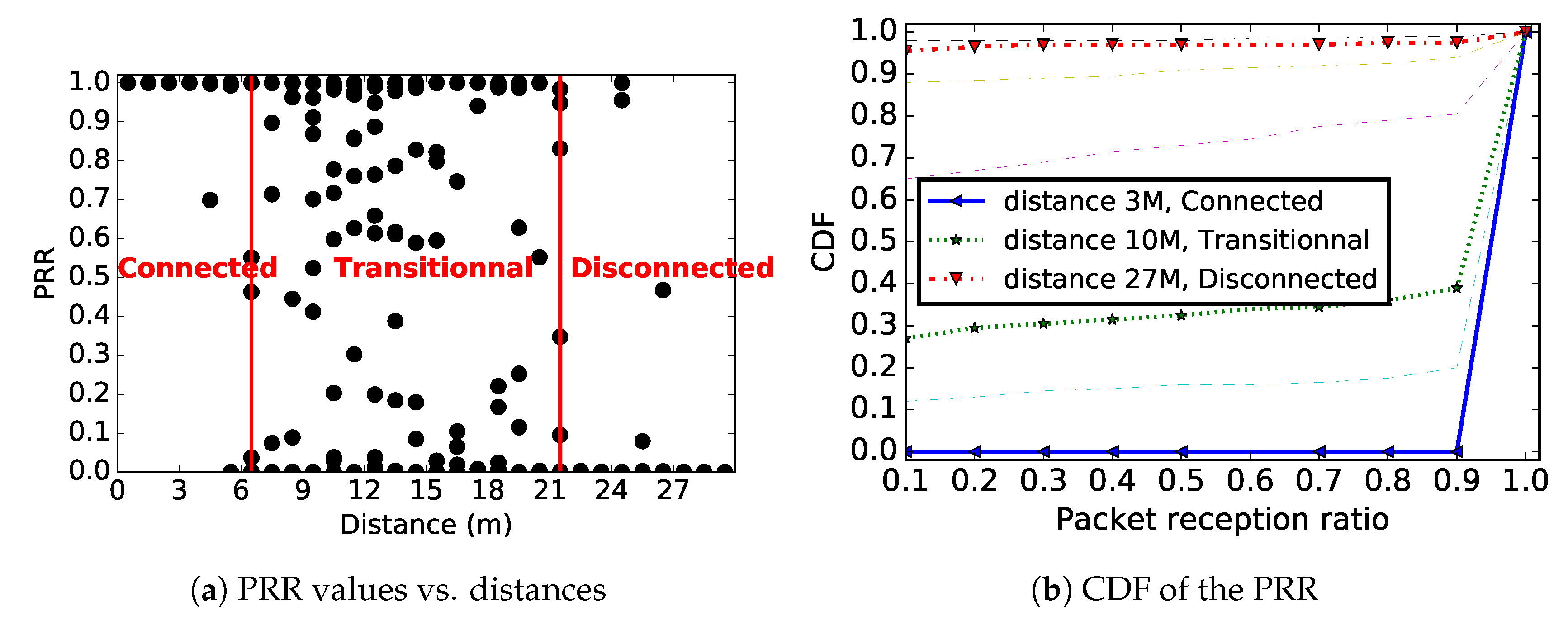

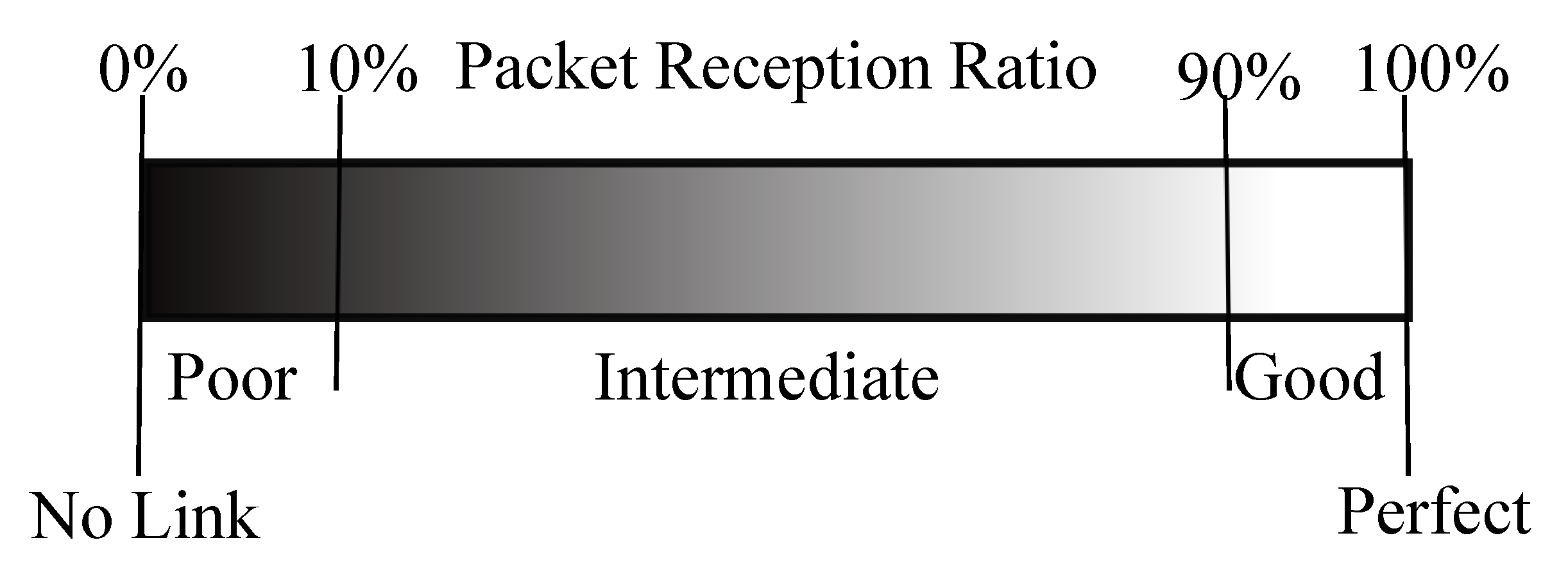
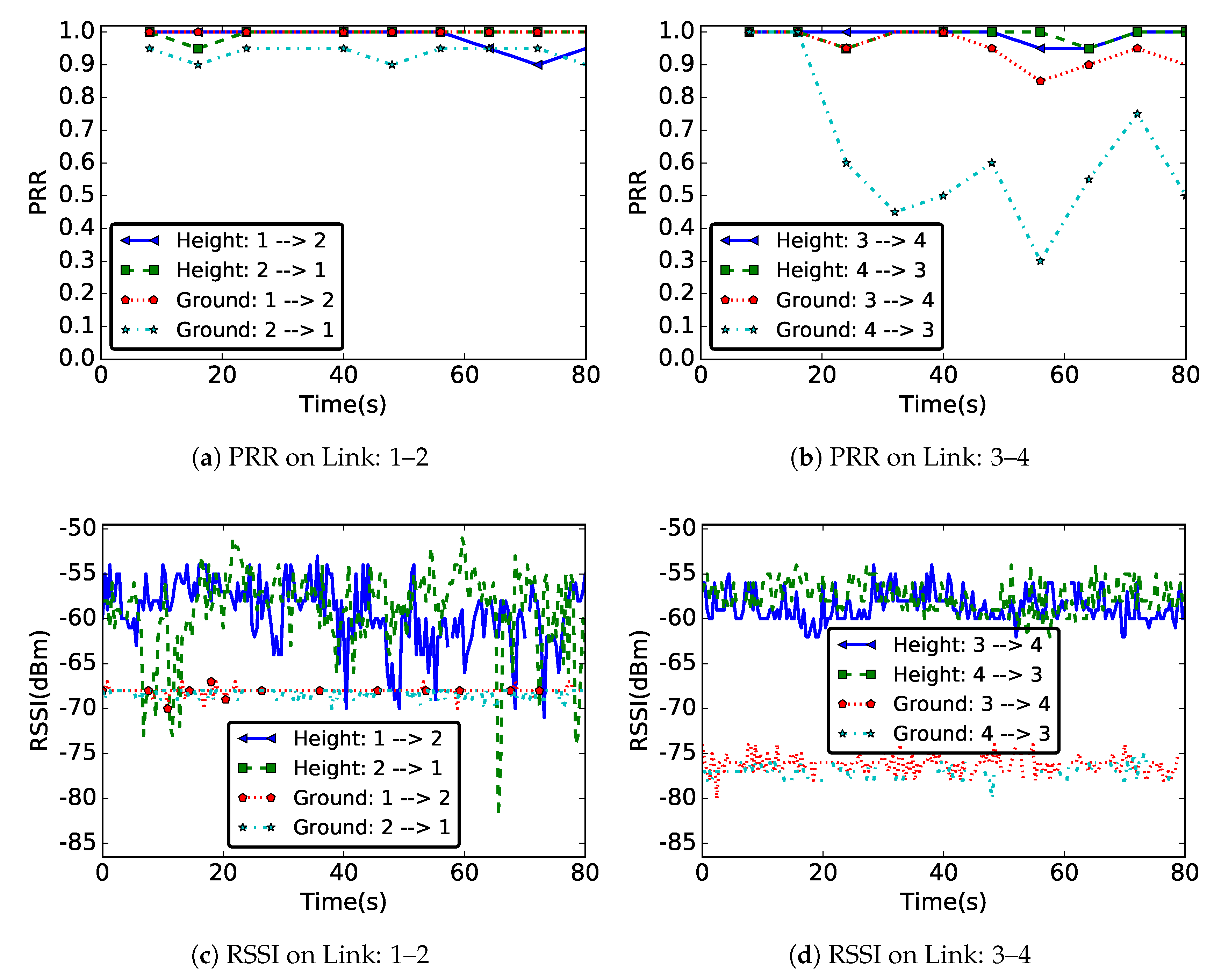

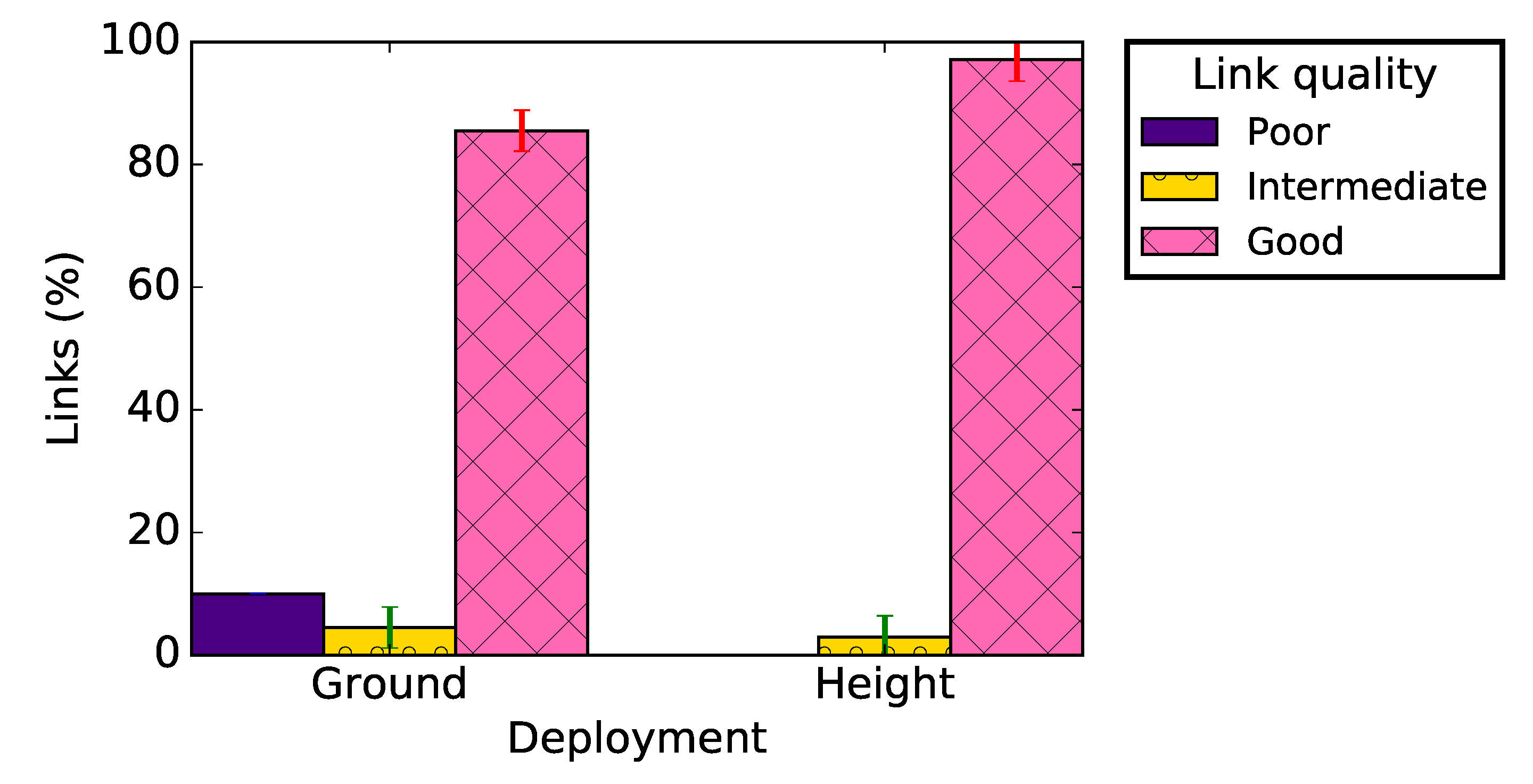

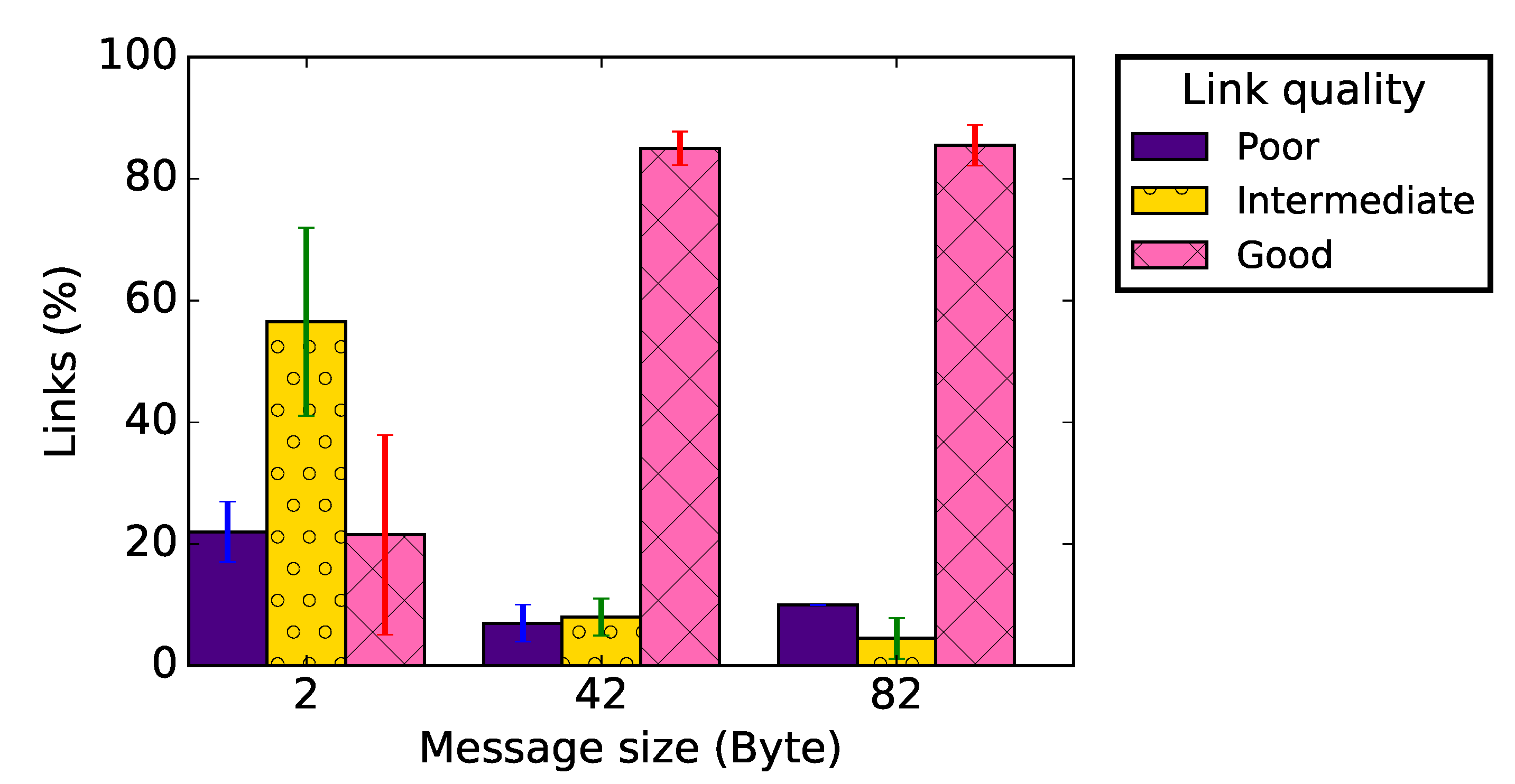
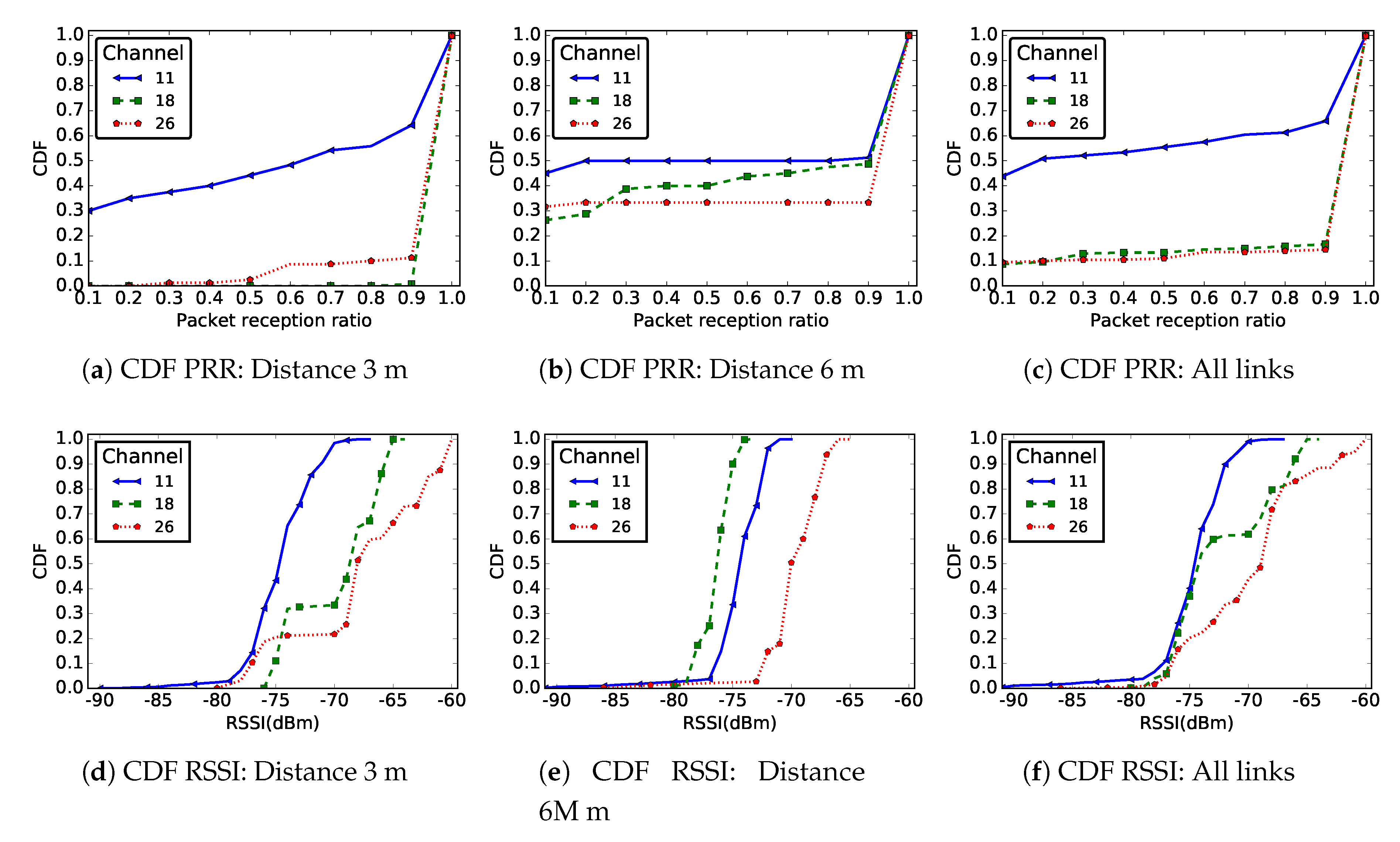


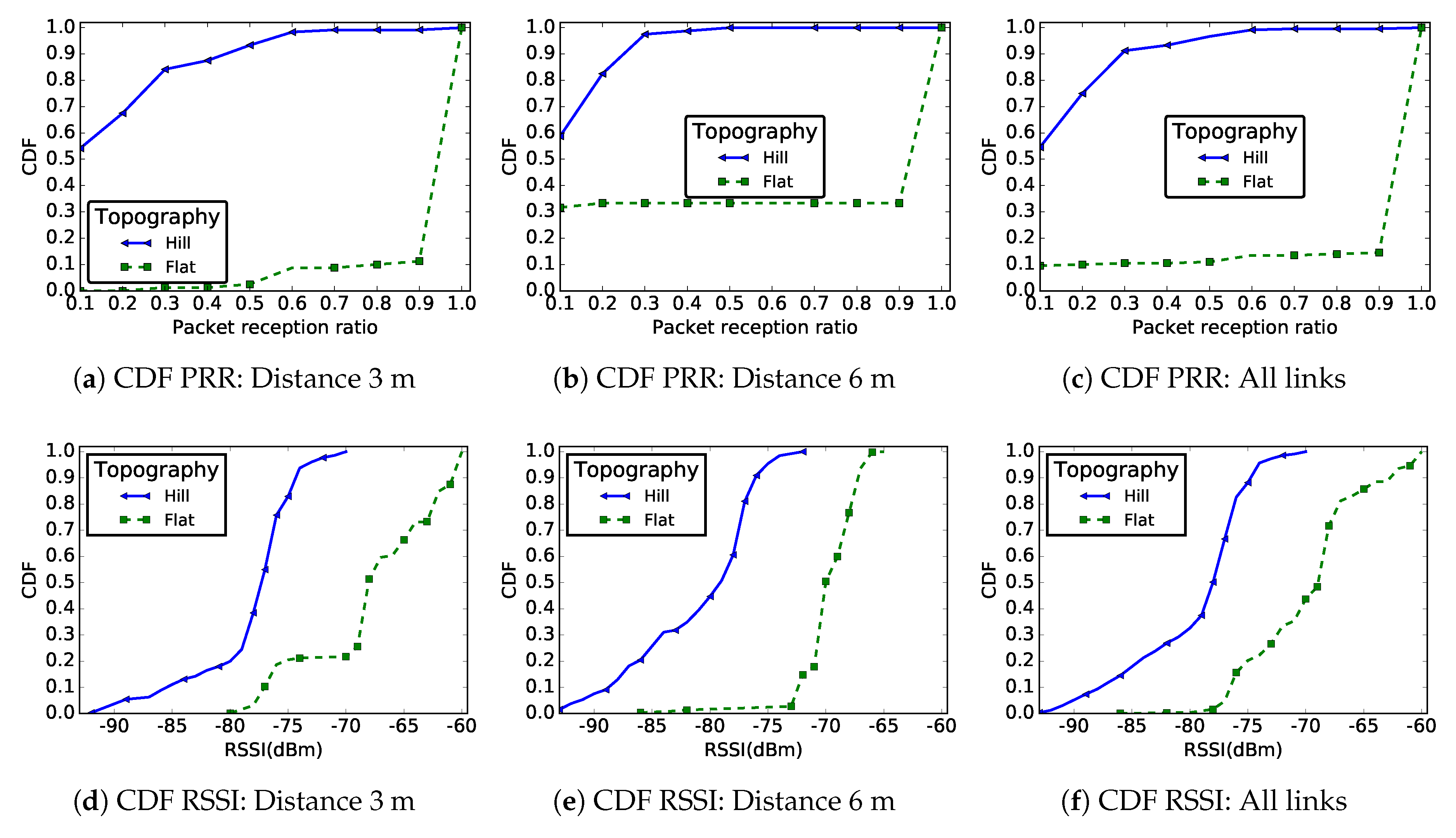
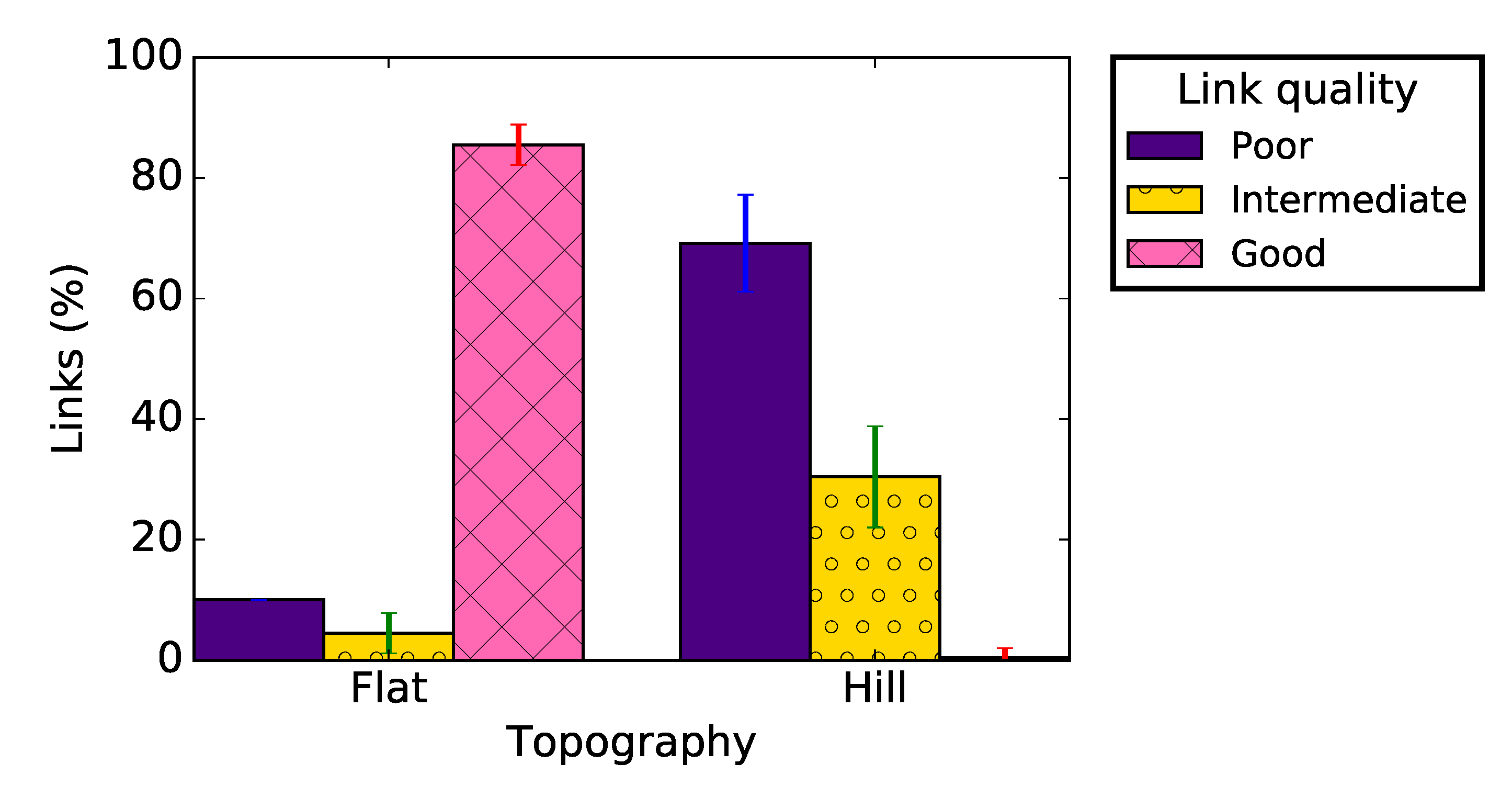

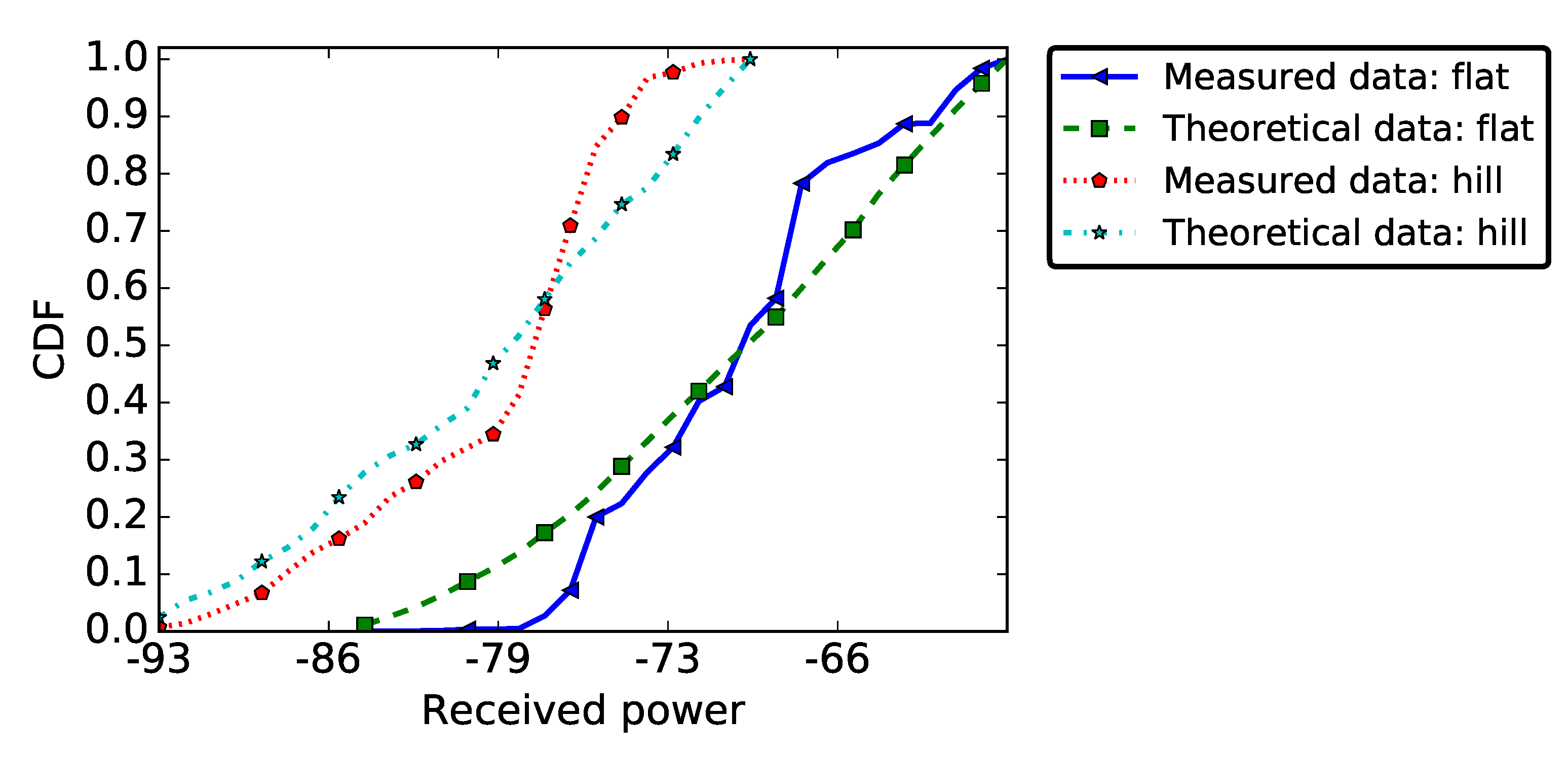
| Ground | Height | |
|---|---|---|
| 0.0505 | 0.04375 | |
| 0.55 | 0.6 | |
| 1.67 | 2.67 | |
| 4.7 | 14.001 | |
| 8 | 0 |
| 2 bytes | 42 bytes | 82 bytes | |
|---|---|---|---|
| 0.2165 | 0.05 | 0.0505 | |
| 0.9 | 0.5 | 0.55 | |
| 1.94 | 1.68 | 1.67 | |
| 4.47 | 5.0 | 4.7 | |
| 18 | 6 | 8 |
| #Channel | 11 | 14 | 18 | 22 | 26 |
|---|---|---|---|---|---|
| 0.09 | 0.01625 | 0.0925 | 0.078 | 0.0505 | |
| 0.9 | 0.1 | 1.0 | 0.75 | 0.55 | |
| 2.35 | 1.652 | 1.3 | 1.81 | 1.67 | |
| 11.67 | 5.0 | 3.9 | 10.43 | 4.7 | |
| 40.83 | 13.33 | 9.11 | 9 | 8 |
| Flat | Hill | |
|---|---|---|
| 0.0505 | 0.1 | |
| 0.55 | 0.4 | |
| 1.67 | 4.3 | |
| 4.7 | 14.75 | |
| 8 | 45.83 |
| Flat deployment | 3.56 | 6.08 |
| Hill deployment | 5.05 | 9.7 |
© 2019 by the authors. Licensee MDPI, Basel, Switzerland. This article is an open access article distributed under the terms and conditions of the Creative Commons Attribution (CC BY) license (http://creativecommons.org/licenses/by/4.0/).
Share and Cite
Domga Komguem, R.; Stanica, R.; Tchuente, M.; Valois, F. Ground Level Deployment of Wireless Sensor Networks: Experiments, Evaluation and Engineering Insight. Sensors 2019, 19, 3358. https://doi.org/10.3390/s19153358
Domga Komguem R, Stanica R, Tchuente M, Valois F. Ground Level Deployment of Wireless Sensor Networks: Experiments, Evaluation and Engineering Insight. Sensors. 2019; 19(15):3358. https://doi.org/10.3390/s19153358
Chicago/Turabian StyleDomga Komguem, Rodrigue, Razvan Stanica, Maurice Tchuente, and Fabrice Valois. 2019. "Ground Level Deployment of Wireless Sensor Networks: Experiments, Evaluation and Engineering Insight" Sensors 19, no. 15: 3358. https://doi.org/10.3390/s19153358
APA StyleDomga Komguem, R., Stanica, R., Tchuente, M., & Valois, F. (2019). Ground Level Deployment of Wireless Sensor Networks: Experiments, Evaluation and Engineering Insight. Sensors, 19(15), 3358. https://doi.org/10.3390/s19153358




